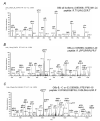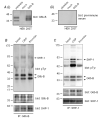A comprehensive proteomics and genomics analysis reveals novel transmembrane proteins in human platelets and mouse megakaryocytes including G6b-B, a novel immunoreceptor tyrosine-based inhibitory motif protein
- PMID: 17186946
- PMCID: PMC1860054
- DOI: 10.1074/mcp.D600007-MCP200
A comprehensive proteomics and genomics analysis reveals novel transmembrane proteins in human platelets and mouse megakaryocytes including G6b-B, a novel immunoreceptor tyrosine-based inhibitory motif protein
Abstract
The platelet surface is poorly characterized due to the low abundance of many membrane proteins and the lack of specialist tools for their investigation. In this study we identified novel human platelet and mouse megakaryocyte membrane proteins using specialist proteomics and genomics approaches. Three separate methods were used to enrich platelet surface proteins prior to identification by liquid chromatography and tandem mass spectrometry: lectin affinity chromatography, biotin/NeutrAvidin affinity chromatography, and free flow electrophoresis. Many known, abundant platelet surface transmembrane proteins and several novel proteins were identified using each receptor enrichment strategy. In total, two or more unique peptides were identified for 46, 68, and 22 surface membrane, intracellular membrane, and membrane proteins of unknown subcellular localization, respectively. The majority of these were single transmembrane proteins. To complement the proteomics studies, we analyzed the transcriptome of a highly purified preparation of mature primary mouse megakaryocytes using serial analysis of gene expression in view of the increasing importance of mutant mouse models in establishing protein function in platelets. This approach identified all of the major classes of platelet transmembrane receptors, including multitransmembrane proteins. Strikingly 17 of the 25 most megakaryocyte-specific genes (relative to 30 other serial analysis of gene expression libraries) were transmembrane proteins, illustrating the unique nature of the megakaryocyte/platelet surface. The list of novel plasma membrane proteins identified using proteomics includes the immunoglobulin superfamily member G6b, which undergoes extensive alternate splicing. Specific antibodies were used to demonstrate expression of the G6b-B isoform, which contains an immunoreceptor tyrosine-based inhibition motif. G6b-B undergoes tyrosine phosphorylation and association with the SH2 domain-containing phosphatase, SHP-1, in stimulated platelets suggesting that it may play a novel role in limiting platelet activation.
Figures




References
-
- Andonegui G, Kerfoot SM, McNagny K, Ebbert KV, Patel KD, Kubes P. Platelets express functional Toll-like receptor-4. Blood. 2005;106:2417–2423. - PubMed
-
- Aslam R, Speck ER, Kim M, Crow AR, Bang KA, Nestel FP, Ni H, Lazarus AH, Freedman J, Semple JW. Platelet toll-like receptor expression modulates lipopolysaccharide-induced thrombocytopenia and tumor necrosis factor-{alpha} production in vivo. Blood. 2005;107:637–641. - PubMed
-
- Watson SP, Authi KS. Preparation of highly purified human platelet plasma intracellular membranes using high voltage free flow electrophoresis and methods to study Ca2+ regulation. 1st Ed. Oxford: Oxford University Press; 1996. pp. 91–109.
-
- Barrow AD, Astoul E, Floto A, Brooke G, Relou IA, Jennings NS, Smith KG, Ouwehand W, Farndale RW, Alexander DR, Trowsdale J. Cutting edge: TREM-like transcript-1, a platelet immunoreceptor tyrosine-based inhibition motif encoding costimulatory immunoreceptor that enhances, rather than inhibits, calcium signaling via SHP-2. J Immunol. 2004;172:5838–5842. - PubMed
-
- Baurand A, Raboisson P, Freund M, Leon C, Cazenave JP, Bourguignon JJ, Gachet C. Inhibition of platelet function by administration of MRS2179, a P2Y1 receptor antagonist. Eur J Pharmacol. 2001;412:213–221. - PubMed
Publication types
MeSH terms
Substances
Associated data
- Actions
Grants and funding
LinkOut - more resources
Full Text Sources
Other Literature Sources
Molecular Biology Databases

